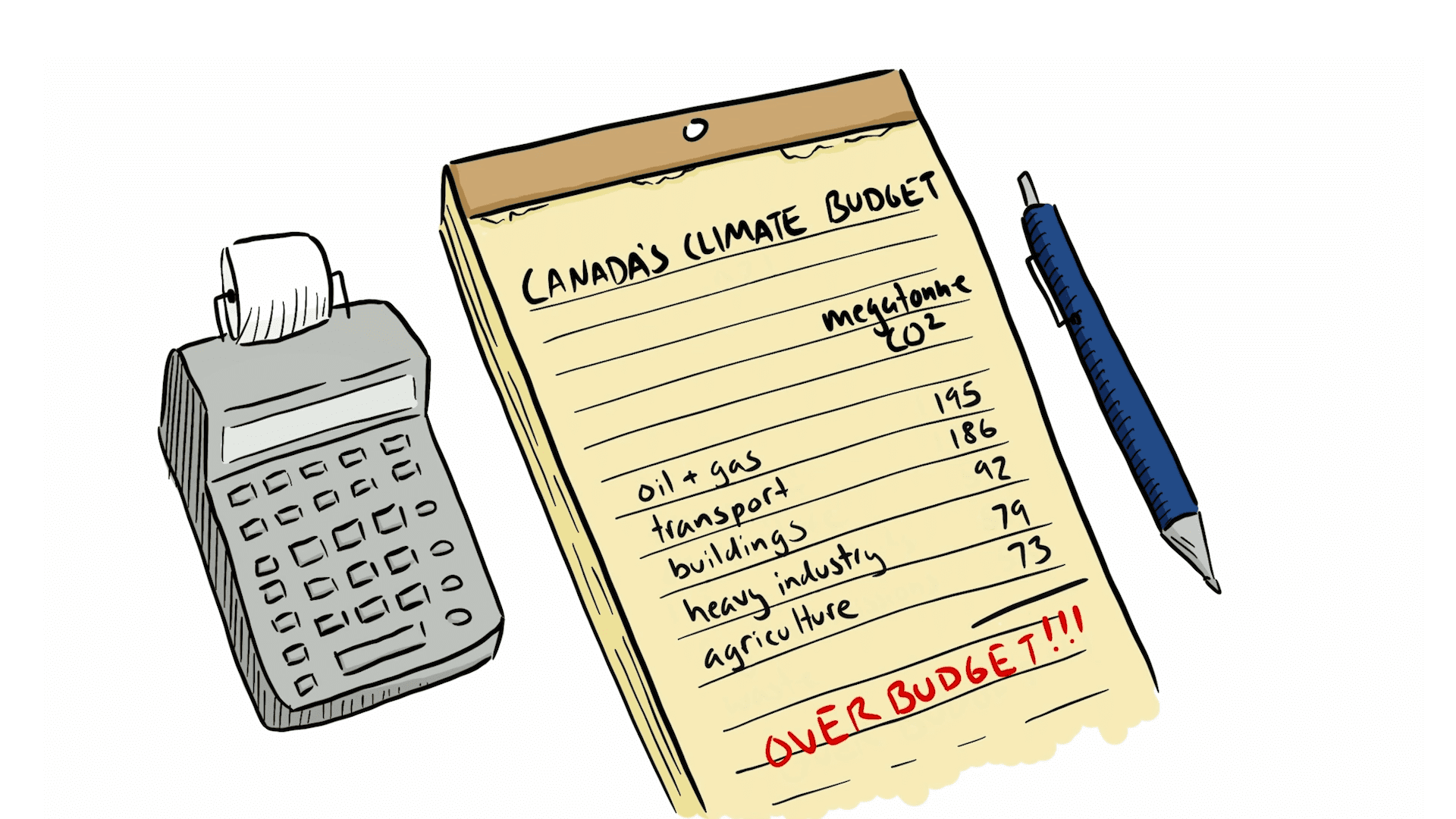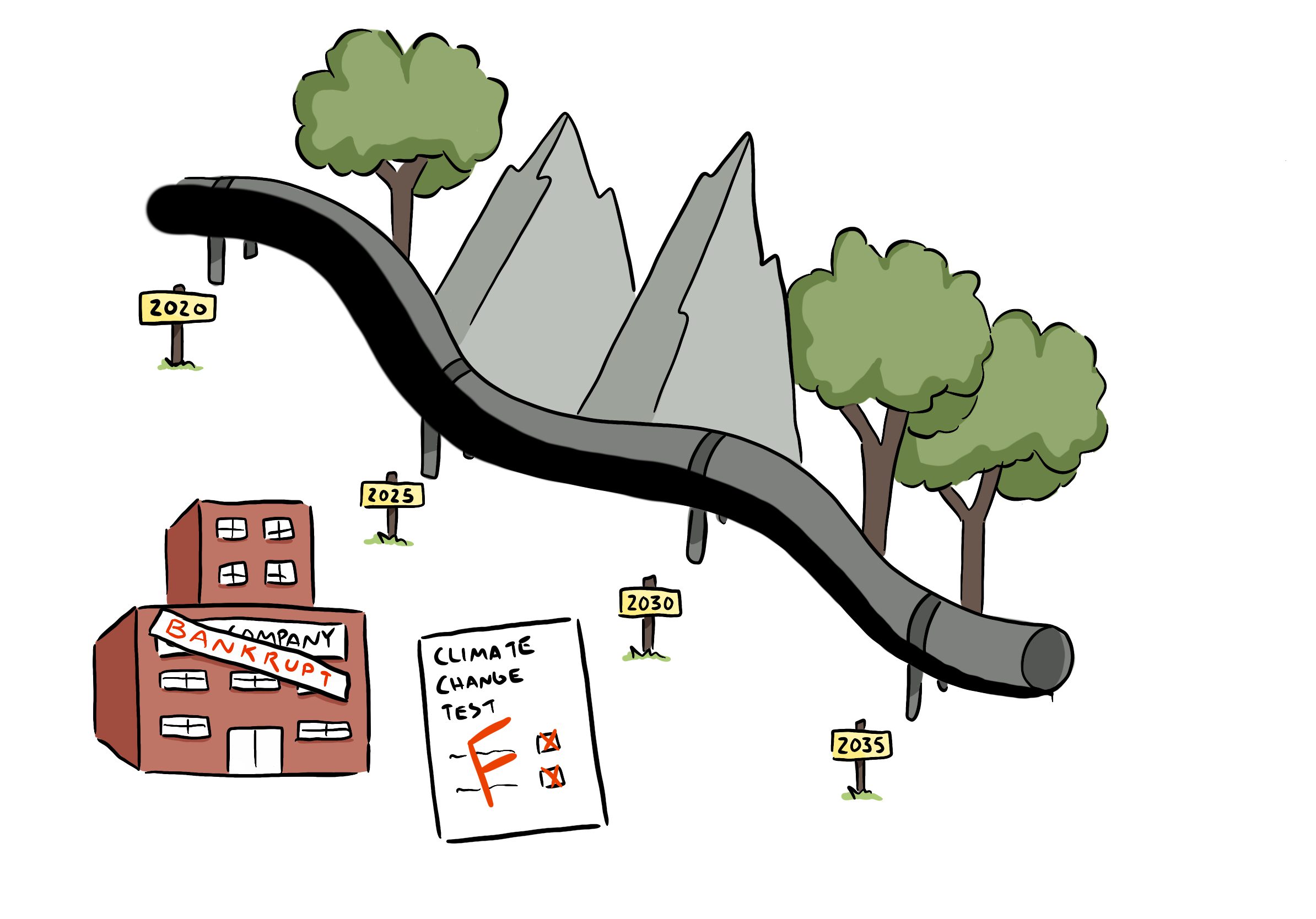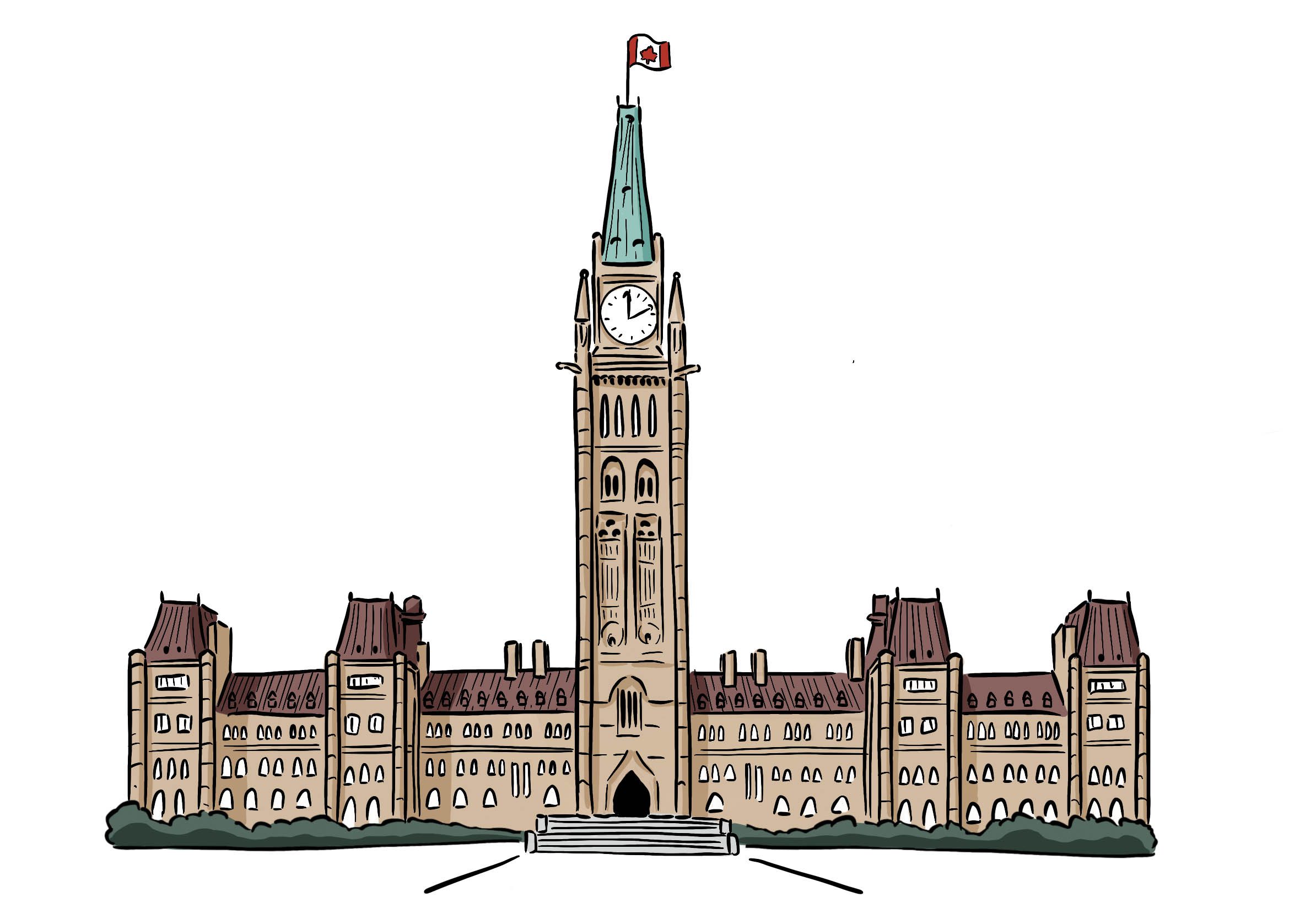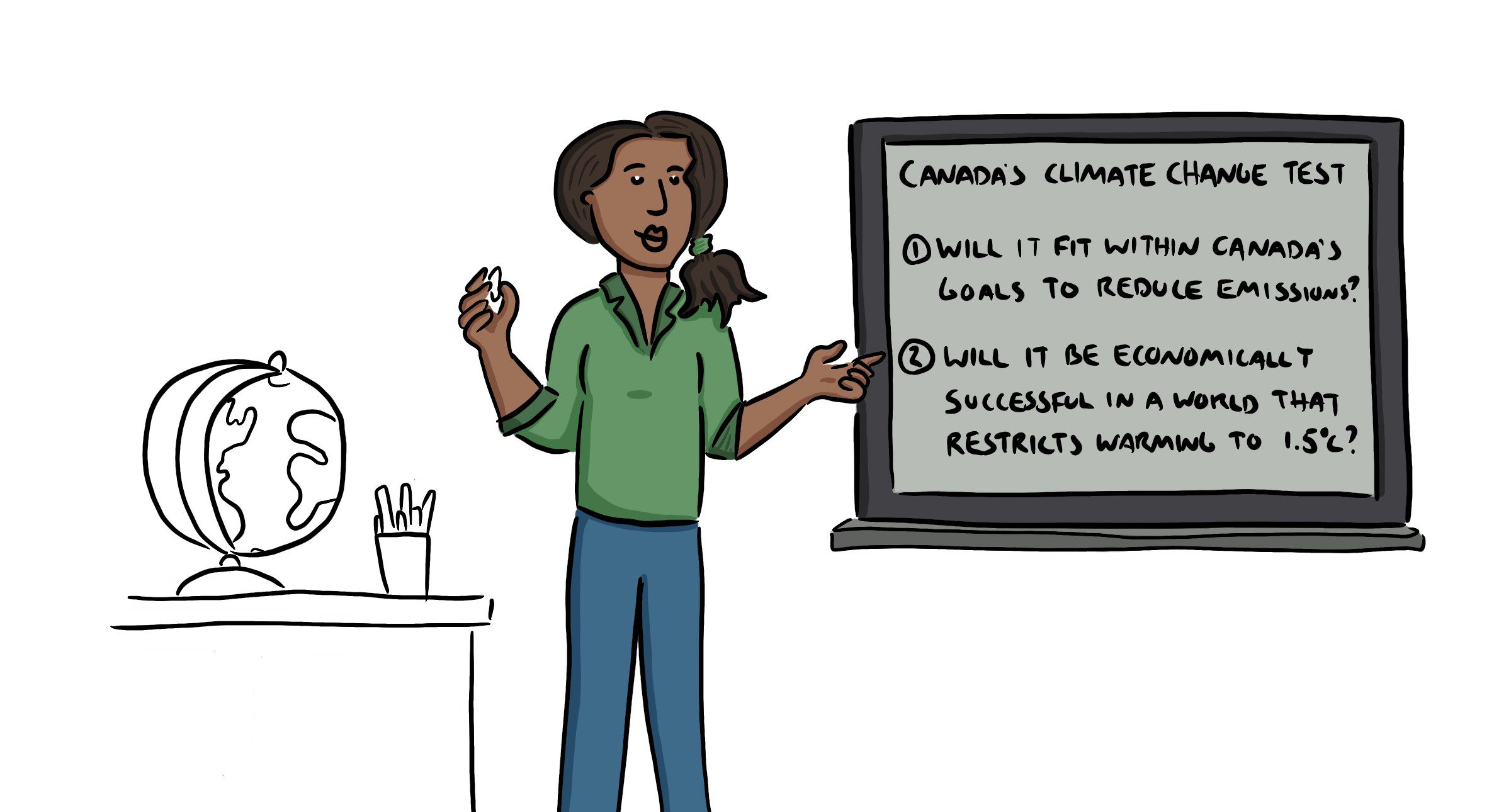We know we need to leave fossil fuels in the ground. The United Nations Environment Program made it clear in its Production Gap report that Canada and other big emitters are planning to produce more than twice the amount of fossil fuels than what is consistent with a climate-safe future
WATCH THE VIDEO ABOUT WHY CANADA NEEDS A CLIMATE CHANGE TEST
Last year, Canada declared a climate emergency. The government has acknowledged that it’s current 2030 climate target – which we’re still way off track to meet – is inadequate and has pledged to do more.
Canada has missed pretty much every climate change promise it has set. That’s because we set climate goals, but when making decisions on whether to approve new things that create emissions – like energy projects, pipelines or other major infrastructure projects – there’s no process for ensuring these decisions are compatible with those goals.
 And so the federal government is forging ahead with fossil fuel pipelines like the Coastal Gaslink Pipeline (despite opposition from the Wet’suwet’en First Nation) and the TransMountain pipeline (despite new analysis showing the pipeline makes no financial sense). And new climate bombs are moving through the impact assessment framework.
And so the federal government is forging ahead with fossil fuel pipelines like the Coastal Gaslink Pipeline (despite opposition from the Wet’suwet’en First Nation) and the TransMountain pipeline (despite new analysis showing the pipeline makes no financial sense). And new climate bombs are moving through the impact assessment framework.
Canada’s federal government is fond of saying that we can build pipelines and still meet our climate promises.We have seen project after project approved with decision-makers making vague statements that they are consistent with our greenhouse gas reduction strategies – without any proof that those declarations are true. Is this political rhetoric or a legitimate argument? One way to answer that question is to apply a “climate change test” to all new major infrastructure projects in order to help determine which new energy and industrial projects make sense for Canada in a world moving away from fossil fuels.
An ideal climate change test has two parts
Every new energy or infrastructure proposal should be vetted based on our climate commitments – a climate change test. The goal of the test should be: does this project make sense in a world where greenhouse gas emissions are going down?
There are two questions a climate change test must answer: do a project’s emissions fit within Canada’s climate targets, and does the project make financial sense in a world transitioning away from oil and gas?
Part 1: Emissions
The first part of the test would determine if a project’s lifecycle emissions fit within Canada’s climate commitments. In order to answer the emissions part of the test, there are different tools that decision-makers can use. The most straightforward tool is a carbon budget.
Step 1: Set the national carbon budget for greenhouse gas emissions
 A “carbon budget” is a way of estimating how much more CO2 we can emit to the atmosphere before we raise global temperature above 1.5 degrees. Just like a household budget, you only have so much to spend any given year – there’s only so much carbon we can emit each year without blowing the budget. (Carbon budgets don’t just operate on a year-to-year basis, but also consider how much we’ve already emitted in the past.) How we choose to spend and invest the remaining carbon in the budget will determine the available budget for future generations. Higher emissions this year, or in the next few years, imply more rapid cuts will be needed later. And the more we dip into the carbon piggy bank, the more serious climate impacts become.
A “carbon budget” is a way of estimating how much more CO2 we can emit to the atmosphere before we raise global temperature above 1.5 degrees. Just like a household budget, you only have so much to spend any given year – there’s only so much carbon we can emit each year without blowing the budget. (Carbon budgets don’t just operate on a year-to-year basis, but also consider how much we’ve already emitted in the past.) How we choose to spend and invest the remaining carbon in the budget will determine the available budget for future generations. Higher emissions this year, or in the next few years, imply more rapid cuts will be needed later. And the more we dip into the carbon piggy bank, the more serious climate impacts become.
Step 2: Determine sector-by-sector and regional budgets
Using our national carbon budget and working backwards, we can also set budgets for provinces and individual sectors of the economy that decrease overtime in line with our national goals. A province with more people likely must emit more than a province with a lower population, for example.
Step 3: Weigh each proposed project against the carbon budget
We can use these budgets to weigh decisions about new infrastructure projects. A climate test would analyze greenhouse gas emissions related to a project (including upstream and downstream emissions) and assess whether it fits within the relevant budgets or not – just like you would when considering a new expense. If the pollution produced by a project breaks the “carbon budget”, then it would fail the climate test.
Part 2: Stop planning for climate failure: better economic modelling
The second part of the climate test would determine if a project makes financial sense in a world that successfully tackles carbon pollution.
 Limiting global warming to 1.5 degrees necessarily means leaving fossil fuels in the ground, and reducing the supply and demand of oil, gas and coal to near-zero by mid-century. High-cost, high-carbon projects like the tar sands would be the first to become uneconomical in a carbon-constrained world. In a sense, the pandemic offers a preview of what will happen. As global oil demand collapsed earlier this year, tar sands projects were some of the first to be shut down. Major financial institutions are taking their money out of Canadian oil and gas. These companies are seeing the writing on the wall as climate change and energy transition increase the financial risks of investment in the tar sands.
Limiting global warming to 1.5 degrees necessarily means leaving fossil fuels in the ground, and reducing the supply and demand of oil, gas and coal to near-zero by mid-century. High-cost, high-carbon projects like the tar sands would be the first to become uneconomical in a carbon-constrained world. In a sense, the pandemic offers a preview of what will happen. As global oil demand collapsed earlier this year, tar sands projects were some of the first to be shut down. Major financial institutions are taking their money out of Canadian oil and gas. These companies are seeing the writing on the wall as climate change and energy transition increase the financial risks of investment in the tar sands.
Because there is no climate change test, Canada is currently basing decisions on which infrastructure projects to approve using “business as usual” demand scenarios for fossil fuels. These scenarios suggest increased demand for decades to come, and are used to justify specific projects, rather than using scenarios consistent with the world’s transition away from fossil fuels. Continuing to use the “business as usual” scenario will result in climate catastrophe. Instead, we should be using economic models consistent with the world’s transition away from fossil fuels to determine whether new projects make economic sense.
If a project only makes sense if it ignores climate change, it would fail the climate change test.
The climate change test needs to be a deal-breaker—if a project fails the test, it doesn’t get approved.
Didn’t we already get a climate change test with Bill C-69?
 Those of you who followed along as we fought for Canada’s new impact assessment framework might have thought we already had a climate change test. We had hoped that the government would implement a carbon test with the introduction of the new Impact Assessment Act (Bill C-69), which requires that project reviews consider whether the impacts help or hinder Canada in achieving its climate commitments. In fact, the Strategic Assessment of Climate Change (SACC) was supposed to do just that. Despite public pressure, the federal government failed to put into place a mechanism to ensure that only projects that are consistent with those goals are built. Even worse, just two months after the final SACC was introduced, after years of consultations, the federal government caved to pressure from the mining industry and further weakened the policy with no public input.
Those of you who followed along as we fought for Canada’s new impact assessment framework might have thought we already had a climate change test. We had hoped that the government would implement a carbon test with the introduction of the new Impact Assessment Act (Bill C-69), which requires that project reviews consider whether the impacts help or hinder Canada in achieving its climate commitments. In fact, the Strategic Assessment of Climate Change (SACC) was supposed to do just that. Despite public pressure, the federal government failed to put into place a mechanism to ensure that only projects that are consistent with those goals are built. Even worse, just two months after the final SACC was introduced, after years of consultations, the federal government caved to pressure from the mining industry and further weakened the policy with no public input.
As a result, Canadians should not expect that future assessments will do a better job of ensuring new projects are consistent with international climate commitments.
Right now, fossil fuel companies are trying to get three major carbon bombs approved, including a proposed LNG pipeline in Quebec (Gazoduq) which in conjunction with the Énergie Saguenay LNG plant would produce 7.8 million tons of greenhouse gas annually, and an expansion of the Vista thermal coal mine; and a huge expansion of a tar sands mine by Suncor Energy which would produce another 3 million tons of carbon pollution each year.
Without a climate change test, the country will have a hard time meeting our climate commitments. Decision-makers won’t be able to tell whether a project fits within our carbon budgets or not.
We can’t keep fighting this fight project by project – that’s not good for Canadians, our governments or businesses. We can’t keep relying on an assessment process that doesn’t adequately factor in our climate commitments.
Watch this video about why Canada needs a climate change test
Stay up-to-date on environmental issues – join our email community today.









